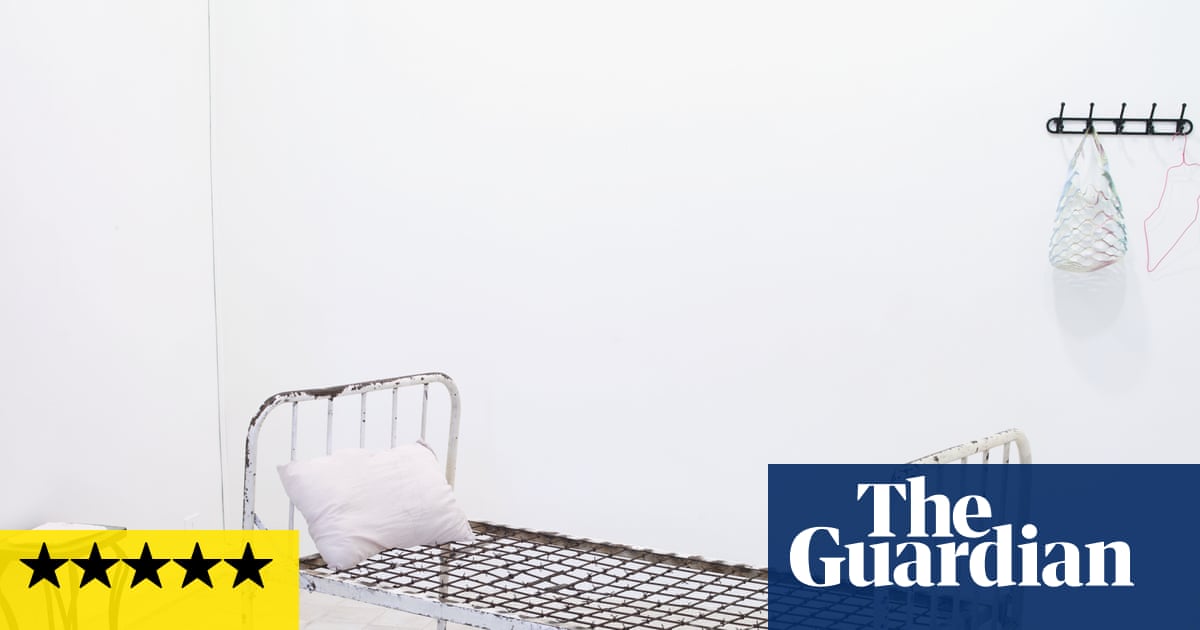Mona Hatoum’s show begins with an indelible afterimage of modern war. Into a stack of welded steel boxes resembling an apartment block in a city that could be anywhere, Hatoum has melted or blasted holes imitating drone or missile strikes. Parts of interior walls and floors have been shorn away to look like apartments with their fronts blown off. This is the shell of what was once a home to many, emptied out by war, like the buildings you saw on the news last night.
Hatoum created Bourj, which means “tower” in Arabic, for an exhibition in Beirut, the city where she was born into a Palestinian family in 1952. Since 1975 she has been based in London but her art knows no peace. Home and family are perforated by violence. A steel cot resembling a prison cell has cheese wire in place of a soft mattress. A kitchen with small chairs for the kids, alongside larger ones for mum and dad, has been incinerated, and the carbonised fragments of wooden furniture painstakingly reassembled inside wire mesh replicas of what they looked like before the disaster.
In a work made this year, a baby’s disembodied arm lies on the ground. Cast from glass it could almost be cute, like a little handprint on a kitchen wall. Except you know it’s not. It filters a horror too terrible to look at or even think about directly: the reality of what happens when you bomb children.
Carbonised fragments … a detail from Hatoum’s Remains of the Day, 2016-2018. Photograph: White Cube/Kitmin Lee/© Mona Hatoum
What, you may wonder, has all this to do with Alberto Giacometti, the Swiss modern sculptor who died in 1966? A lot, it turns out. This is the second in a series of exhibitions that juxtapose Giacometti with contemporary artists. In the first, he was made to look old and safe by the wildly creative Huma Bhabha, but this is a more complex, reciprocal conversation – between Hatoum and an artist she loves, or at least finds common cause with against a terrifying world. Her cheese wire prison cot, Incommunicado, stands next to Giacometti’s most brutal work, his 1932 bronze Woman with Her Throat Cut: a sprawled body on the ground, opened up like an anatomical model, resembling a giant praying mantis with a long, exposed oesophagus and a head that is a tiny screaming mask.
Giacometti was part of the surrealist movement when he created this splayed frenzy. Does it wallow in the macabre? Hatoum suggests you have to do that to capture the violence of reality in art. Close by she places her piece A Bigger Splash: six giant, blood-red splashes that she cast in glass in a workshop in Murano. Most artists working in Venice would be inspired by sunsets or canals but for Hatoum it’s always blood. She – unlike David Hockney, whom she mocks with her title – can’t forget the world’s anguish. And she sees a fellow spirit in Giacometti.
A cartoon kitty on the prowl … Giacometti’s The Cat, 1951. Photograph: Fondation Giacometti
That empathy with an artist who died when she was 14 takes an extraordinary twist when they create a joint work. Giacometti’s The Nose, made in 1947, looks like the grinning skull of a commedia dell’ arte clown, out of which sprouts a thin spear of a nose. Here, it is displayed inside Hatoum’s prison-cell-like Cube, a steel cage just big enough for a person. Their “joint” artwork is an unholy installation of nihilistic despair. Giacometti’s carnivalesque death mask – he said it grew out of watching people die, their noses appearing to enlarge as their cheeks sank – is a prisoner in Hatoum’s image of authority, abuse, oppression.
skip past newsletter promotion
Your weekly art world round-up, sketching out all the biggest stories, scandals and exhibitions
Privacy Notice: Newsletters may contain information about charities, online ads, and content funded by outside parties. If you do not have an account, we will create a guest account for you on theguardian.com to send you this newsletter. You can complete full registration at any time. For more information about how we use your data see our Privacy Policy. We use Google reCaptcha to protect our website and the Google Privacy Policy and Terms of Service apply.
after newsletter promotion
What the two share is a seriousness about life, a refusal to shy away from the modern world’s pain. But Hatoum’s eye for Giacometti’s black humour also leads her to include his delightful 1954 sculpture Cat, a long, slender cartoon kitty on a permanent prowl. It’s the feline equivalent of his walking human figures, and while they resemble Etruscan funeral statuettes, this puss looks like an Egyptian mummified feline. Archaeology is for both these artists a bedrock of the human. Near Giacometti’s cat, Hatoum shows her Terracotta Tile, a red tile with a dog’s paw-print in it – her homage to ancient Roman tiles that still preserve the prints of pooches who died 2,000 years ago.
Sculpture has changed a lot since Giacometti’s death but this series proves what magnificent power it has in our century. Hatoum shares Giacometti’s grief, terror and compassion even though their attitude to media is very different. Back in 1985 she walked doggedly through Brixton, barefoot, with Doctor Marten boots tied to her ankles. The video of this performance is shown here close to a Giacometti striding statuette. She pounds the streets, watched by puzzled passers by, dragging the weight of those empty boots – the weight of the world.

